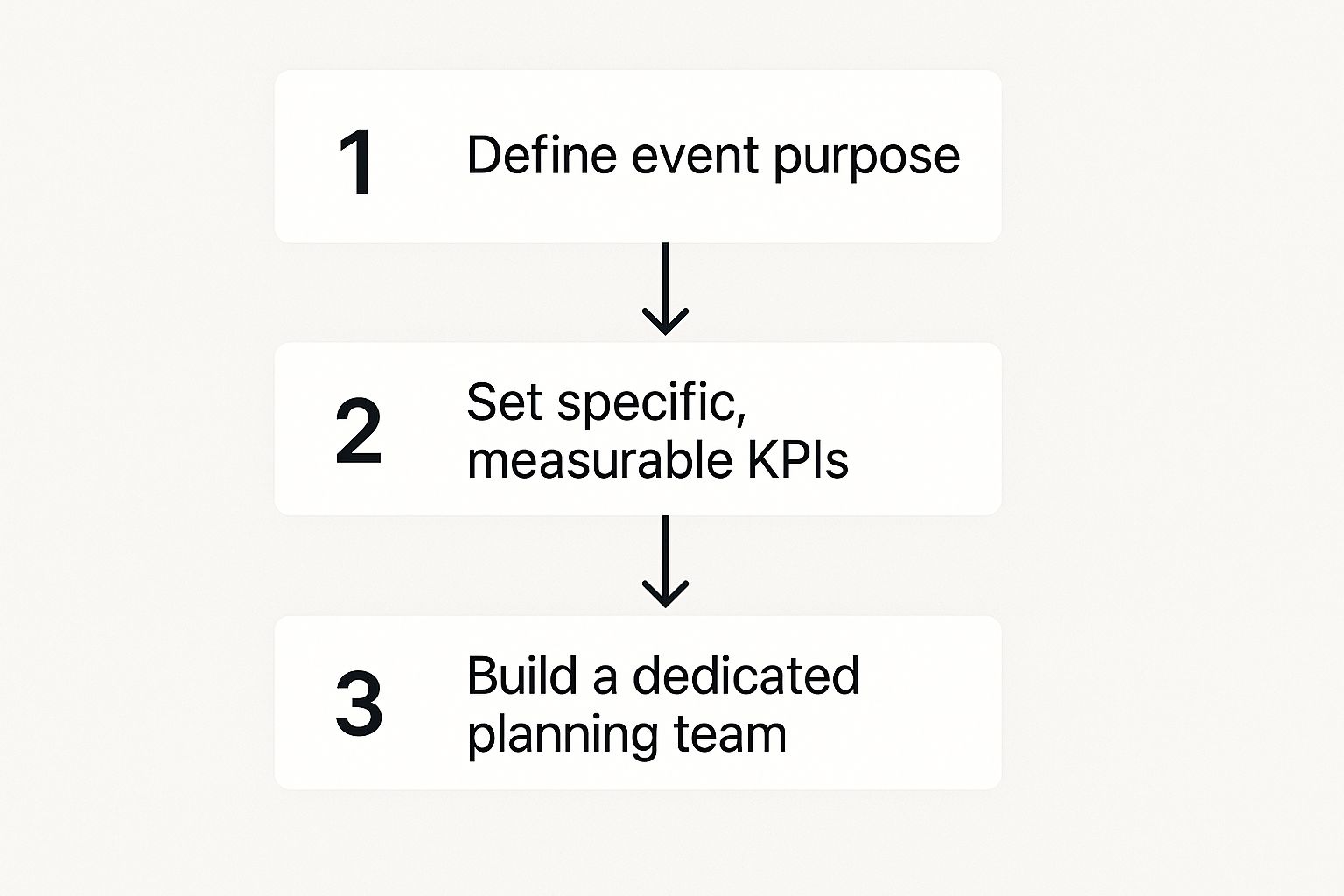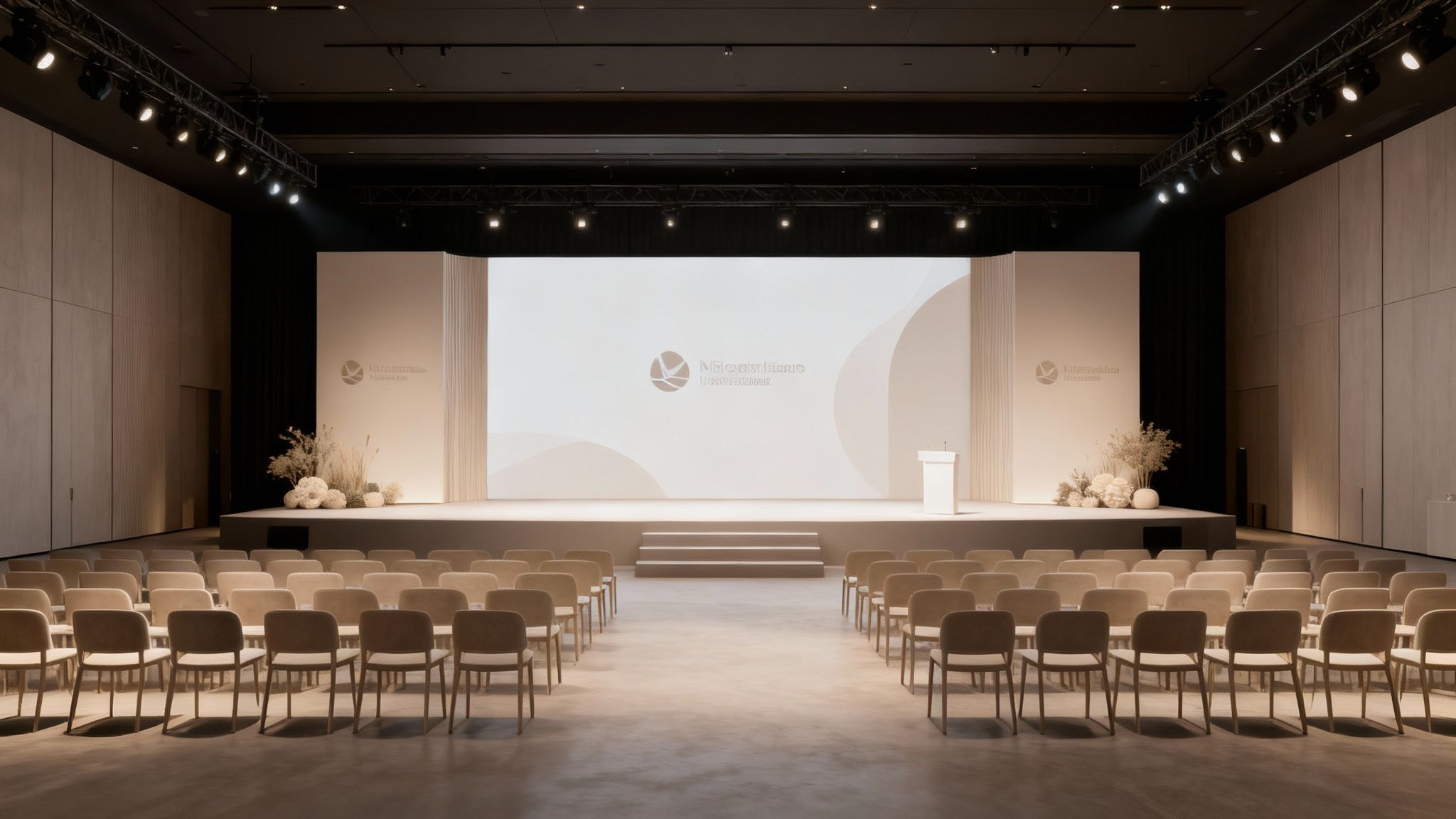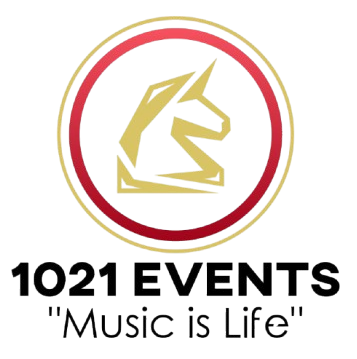To pull off a corporate event that people actually remember, you need to start with a solid game plan. That means defining a clear purpose, setting goals you can actually measure, and getting the right people on board from day one. This initial blueprint is your North Star—it guides every decision you’ll make, from the budget to the final vendor choice, and keeps the whole project on track.
Setting the Stage for Event Success
Before you even think about looking at venues or tasting catering samples, the most important work needs to happen. The real secret to a killer corporate event isn't just about perfect logistics; it’s about laying a rock-solid foundation. Get this part right, and you'll save yourself from expensive last-minute changes and a whole lot of stress later.
It all starts with a simple question: Why are we doing this? Without a clear answer, your event will feel random and forgettable. Are you trying to drum up new sales leads? Maybe you're celebrating a huge company milestone, or perhaps it's about getting your team trained up on something new.
Once you’ve got your "why," you can figure out the "what." This is where you set specific, measurable goals that will prove the event was a home run.
Define Your Purpose and Key Metrics
Vague goals like "improving morale" or "building brand awareness" are impossible to track. You need to turn those fuzzy ideas into concrete Key Performance Indicators (KPIs). This is what separates strategic event planning from just throwing a party.
Let’s get specific:
- Product Launch: Your goal could be to generate 50 qualified leads from the people who show up or to land 10 media placements.
- Employee Appreciation: Aim for a 90% attendance rate and look for a 15% jump in positive feedback on the next employee engagement survey.
- Industry Conference: A solid goal would be to add 200 new contacts to your sales pipeline.
Nailing these metrics down from the get-go is everything. It doesn't just help you justify the budget; it helps your entire team focus on what really matters. If you need some help, you can learn more about how to measure event success to build a solid framework right from the start.
A successful event isn't just one that goes off without a hitch. It's one that hits a specific, predetermined business goal. Your KPIs are the proof.
The event world is always changing, thanks to new tech and a serious demand for unique experiences. Did you know that over 85% of planners are now using event management software? And for 52% of them, just getting people to show up is their biggest headache. This just goes to show how important it is to have a smart strategy from the very beginning.
To get started, try filling out this simple framework. It's a great way to define the core pillars of your event before you get lost in the nitty-gritty details.
Your Initial Event Planning Framework
| Planning Pillar | Key Questions to Answer | Example Objective |
|---|---|---|
| Event Purpose | Why are we hosting this event? What is the primary business reason? | To launch our new software and generate high-quality B2B leads. |
| Target Audience | Who are we trying to reach? What are their needs and expectations? | CTOs and IT Directors from mid-sized tech companies in the region. |
| Key Metrics | How will we measure success? What specific numbers will we track? | Generate 50 qualified leads and book 15 product demos post-event. |
This table forces you to think through the most critical elements first, ensuring your logistics always serve your strategy—not the other way around.
Assemble Your Core Planning Team
Let's be real: you can't plan a corporate event by yourself. Putting together a small, dedicated team is non-negotiable for managing the workload and getting different viewpoints. But this isn't about grabbing anyone with a free afternoon; it's about picking people with the right skills for the job.
Ideally, your dream team includes:
- A project manager to keep the timeline and budget in check.
- A creative lead to handle the event's theme and overall vibe.
- A logistics coordinator to manage vendors, the venue, and all the on-the-ground details.
- A marketing or comms pro to get the word out and manage all attendee communication.
This infographic gives you a great visual of how these foundational steps flow together.

As you can see, locking in your purpose, KPIs, and team first creates a strong strategic base. Everything else you do will build on this foundation.
Nailing Down a Realistic Budget and Timeline
Alright, you know why you're having an event and who's helping you pull it off. Now comes the real test: mapping out the money and the time. These two pieces can absolutely make or break your event, and getting them right from the start is the key to a smooth, stress-free planning process.
Think of your budget and timeline as the guardrails on a winding road. They keep you on track, prevent that dreaded scope creep (we’ve all been there), and make sure your brilliant vision is actually affordable. Without them, you're basically just winging it and hoping for the best.
Crafting Your Event Budget
Building a budget is way more than just scribbling down a few numbers. It’s a strategic deep dive into every single potential cost, from the big-ticket items down to the tiniest details. I’ve seen too many planners get blindsided by hidden fees and unexpected charges that weren't in the initial quote.
To avoid that headache, start by breaking everything down into major categories. It makes the whole thing feel less overwhelming and shows you exactly where your money is going.
Here are the usual suspects you need to account for:
- Venue Rental: This is almost always your biggest line item.
- Food & Beverage: Think per-person costs for everything from the welcome coffee to the closing cocktail.
- A/V and Tech: Microphones, projectors, lighting, staging, and reliable Wi-Fi don't come cheap.
- Marketing & Promotion: Don't forget the budget for invites, social media campaigns, and event signage.
- Staffing & Security: You'll need people on the ground—event staff, technicians, and maybe security.
It's really no surprise that 40% of planners say budget management is one of their biggest headaches, often because of surprise A/V costs or food and beverage overages. The good news? Tech is catching up. About 50% of meeting planners are now using AI-powered tools to get a better grip on spending and streamline their workflows.
Pro Tip: This is non-negotiable in my book. Always—and I mean always—add a 10-15% contingency fund to your total budget. This is your safety net for everything that can and will go wrong, like last-minute equipment rentals, staff overtime, or a vendor's sudden price hike.
To get started on the right foot, grab a structured template. We've put together a comprehensive event budget template to make sure you don't miss a thing. It helps you track every dollar and make smart decisions on where to allocate funds for the biggest impact.
Reverse-Engineer Your Timeline
Here’s a classic rookie mistake: planning a timeline from today forward. A much smarter—and less chaotic—way to do it is to work backward from the event date. I call this "reverse-engineering" your timeline, and it creates a crystal-clear, deadline-driven path that ensures nothing gets missed.
Just plug in your event date and start mapping out key milestones in reverse. It immediately creates clarity and a healthy sense of urgency for the whole team.
Key Timeline Milestones (Working Backwards)
- 1 Week Out: Finalize the run-of-show, triple-confirm arrival times with all vendors, and send out those final "see you soon" reminders to attendees.
- 1 Month Out: Lock in your final guest count with the venue and caterer. It's time to finalize seating charts and get those name badges printed.
- 2-3 Months Out: The official invitations go out, and your main marketing push kicks into high gear. By this point, all your major vendors (catering, A/V, entertainment) should be booked and have their deposits.
- 4-6 Months Out: Secure your venue. This is the big one. The best spots get booked up a year or more in advance, so you can't drag your feet on this.
- 6+ Months Out: This is the foundational stage. Define your event goals, lock in your budget, and get your planning team assembled.
When you plan backward like this, a massive, intimidating project suddenly becomes a series of small, manageable tasks with clear due dates. It helps you focus on what needs to be done right now and keeps those last-minute frantic scrambles at bay.
Finding the Perfect Venue and Vendors

Okay, with a budget and timeline in hand, we get to the fun part: picking the place and the people who will bring this whole thing to life. Your venue is so much more than just four walls and a roof; it sets the entire tone the moment your guests walk in. And your vendors? They're the special forces team making the magic happen behind the scenes.
These are the decisions that can make or break your event. I've seen it happen. A breathtaking venue with spotty Wi-Fi can completely derail a tech conference. A brilliant caterer paired with a clumsy A/V crew creates a jarring, unprofessional experience. It’s all about finding the right fit for your specific goals, not just your budget.
Vetting Your Event Venue
When you're doing a site visit, you have to look past the slick brochures and staged photos. Sure, capacity and location are the big-ticket items, but it's the little details that will save you from major headaches on the day of the event.
Before you get swept away by a cool-looking space, make sure you get clear answers on these non-negotiables:
- Tech Check: Do they have an in-house A/V team, or are you on your own? Seriously, ask them for the real Wi-Fi speed and how many devices it can handle. A weak connection will kill any interactive elements or live streams you have planned.
- Logistics and Flow: Is the venue truly accessible for everyone? Think about more than just a ramp—consider parking, public transport, and how easily people can move between different sessions or rooms. If you’re bussing people in, you’ll want to line up reliable group transportation services early on.
- The Fine Print: Are there weird rules about branding or decorations? Some venues lock you into their preferred (and often overpriced) caterers or A/V companies, which can gut your budget and creative freedom.
A good venue manager will be upfront about what they can and can't do. If their answers are vague or they seem inflexible, that's a red flag. Keep looking.
I once booked this gorgeous industrial loft for a product launch. Looked amazing. What we completely failed to check was the cell service, which was basically a black hole. Our event app, which we'd spent a fortune on, was totally useless. It was a painful lesson in checking every single technical detail.
Assembling Your Vendor Dream Team
Think of your vendors—the caterer, photographer, production crew—as an extension of your own team. You're not just buying a service; you're building a partnership for a high-stakes, one-time project. You need people who are not only masters of their craft but who also get what you're trying to achieve.
Your best bet is to start with recommendations from industry friends or even the venue itself (if they don't have a restrictive policy). Once you've got a shortlist, it's time to dig in. And this is about way more than just comparing prices.
Key Questions to Ask Potential Vendors
When you're interviewing vendors, get past their highlight reel. You need to know how they work, how they communicate, and what happens when things go wrong.
| Vendor Category | Essential Question | Why It Matters |
|---|---|---|
| Catering | Can we do a tasting based on our specific menu and budget? | This shows you exactly what they can deliver for your price point. No surprises. |
| A/V & Production | Who is my single point of contact on the day of the event? | You need one person to call when a mic dies, not a generic 1-800 number. |
| Photography | What's your backup plan if you have a personal emergency? | A true professional will have a network and a plan to ensure you're never left without coverage. |
After you've made your picks, it’s all about the contract. Be meticulous here. Read every single line, paying close attention to cancellation clauses, payment deadlines, and the exact scope of work. A good event venue contract template can show you what to look out for. Don't ever be afraid to ask for changes before you sign. Getting this stuff crystal clear upfront is the secret to a smooth event where everyone is on the same page.
Designing an Unforgettable Attendee Experience

Let's be honest, a great event is more than just a slick schedule and good catering. It’s an immersive experience that sticks with people long after they've headed home. This is where we shift from logistics to the actual human journey—turning a forgettable meeting into an impactful, buzz-worthy affair.
The secret is to put yourself in your attendees' shoes. What would make them actually put their phones away and lean in? It all starts with an agenda that respects their time and delivers real value, not just a death-by-PowerPoint marathon.
Building a Compelling Event Agenda
Think of your agenda as the story of your event. A monotonous, poorly paced schedule can suck the energy right out of a room, no matter how brilliant your content is. You’re aiming for a rhythm that balances learning with networking and, just as importantly, a little bit of breathing room.
I've seen it a thousand times: attention spans are short. Shorter, more dynamic sessions almost always win out over long, rambling keynotes.
- Vary Your Formats: Mix it up. After a dense panel discussion, throw in a hands-on workshop or a lively Q&A. This kind of variety keeps everyone mentally fresh and tuned in.
- Schedule Ample Breaks: Don't just plan for lunch. Weaving in 15-20 minute networking or coffee breaks between sessions is crucial. This is where the real magic happens and the best connections are made.
- Front-Load the Day: Your audience is most alert in the morning, so schedule your heaviest hitters and most important sessions then. Save the lighter, more interactive stuff for that post-lunch slump.
Beyond the schedule itself, the people on stage can make or break the day. Finding speakers who can captivate an audience, not just read from a script, is an art. Look for people known for their dynamic presentation style, not just their list of credentials.
Crafting a Modern Marketing Strategy
You can plan the most incredible event on the planet, but it's all for nothing if nobody shows up. Your marketing strategy is what builds that can't-miss feeling and convinces people to clear their calendars. It’s all about answering that one crucial question for your audience: "What's in it for me?"
First, create a strong event identity. This means a clear theme, sharp branding, and a value proposition that grabs attention instantly.
From there, it’s a multi-channel game:
- Email Campaigns: Don't just blast everyone. Create a segmented email sequence that starts with a "save the date," builds excitement with speaker reveals and early-bird offers, and wraps up with essential "know before you go" info.
- Social Media Buzz: A unique event hashtag is non-negotiable. Use it to share behind-the-scenes glimpses, snappy speaker quotes, and interactive polls to get a community buzzing before the doors even open.
- Internal Communications: If it’s an internal event, a simple calendar invite won't cut it. Use your company's own channels to build hype, clarify the purpose, and get leadership to champion attendance.
When you're hosting at a hotel or conference center, don't overlook the tech. Integrating superior hospitality WiFi solutions is a must. A solid connection means attendees can engage with your event app, post on social media, and stay connected without any frustrating glitches.
The heart of great event marketing is storytelling. You're not just selling a ticket; you're selling an experience—a chance to connect, learn something new, and maybe even advance a career.
Incorporating Interactive and Engaging Elements
Nobody enjoys being talked at for hours. To create a truly memorable experience, you need to get your audience involved. Today's attendees expect to be participants, not just spectators. This is your chance to get creative and inject some life into the proceedings.
Adding unique, unexpected moments is what separates a good event from a great one. So many planners overlook the power of entertainment, but you can find tons of unique https://1021events.com/corporate-event-entertainment-ideas/ that break up the day and create a fun, relaxed vibe for networking.
Think about weaving in a few of these interactive ideas:
- Live Polling and Q&A: Use simple mobile tools to let the audience vote on topics or send questions to speakers in real time. It's an instant engagement booster.
- Gamification: A little friendly competition goes a long way. Try a leaderboard for the most active person on the event app or even a scavenger hunt with cool prizes.
- Networking Hubs: Designate a comfy, well-lit area specifically for conversations. Stock it with charging stations and coffee, and watch organic networking happen away from the main stage hustle.
These elements aren't just fluff; they transform your event from a one-way broadcast into a two-way conversation. They signal to your attendees that their presence matters, making the entire experience feel much more valuable and memorable.
Making It Happen on Game Day

After months of planning, the day of your event has finally arrived. This is where all those spreadsheets, emails, and phone calls transform into a real, live experience for your guests. Pulling off a smooth event comes down to two things: tight coordination and being ready for anything.
The first thing you absolutely have to nail is the technology. Trust me, nothing kills the energy in a room faster than a microphone that won't work or a presentation that won't load.
Before anyone walks through the door, you need to do a full-blown A/V rehearsal in the actual space. Don't just tap the mic and say "testing, one, two." You need to run through every single presentation, play every video clip, and test every lighting change. If you're running a hybrid event, this is your last chance to check the live stream and make sure your remote attendees can actually see and hear what's happening.
Wrangling the On-The-Ground Logistics
Once the tech is locked in, it's all about the people and the timing. The secret weapon for a seamless event day is what we in the business call the run-of-show. This isn't just an agenda; it’s a hyper-detailed, minute-by-minute script for the entire day, from the first truck arriving for setup to the last chair being stacked.
A solid run-of-show includes:
- Vendor Call Times: Exactly when catering, A/V, and entertainment need to be on-site.
- Team Roles: Who is handling check-in? Who is the point person for speakers? Make it crystal clear.
- Critical Cues: When does the walk-in music fade out? Who gives the signal for the keynote to take the stage?
- Emergency Contacts: Every key player’s cell number and backup plans for common issues.
Get this document into the hands of your entire crew—staff and vendors alike—at least a day in advance. Then, right before the doors open, pull everyone together for a quick on-site huddle. Go over the key moments, confirm everyone knows their job, and answer any last-minute questions. This one meeting gets everyone on the same page. For bigger, more complex shows, this is where professional corporate event production services are worth their weight in gold, as they live and breathe this kind of detailed coordination.
Expect the Unexpected (Because It Will Happen)
Let's be real: no matter how much you plan, something will go wrong. Your keynote speaker will get stuck in traffic. The presentation clicker will die mid-sentence. A sudden rainstorm will pop up two minutes before your outdoor reception starts. The mark of a true pro isn't avoiding problems—it's handling them so smoothly that no one even notices.
You have to think like a chess master, always seeing three moves ahead. If the main speaker is late, what’s your plan to fill that 15-minute gap? If the venue’s Wi-Fi crashes, are the presentations saved locally on a laptop? Staying calm and having a plan is your most powerful tool.
This kind of preparation is more critical than ever. The corporate events market is massive, projected to hit USD 326.60 billion by 2025. As the industry grows and hybrid events add new layers of complexity, having solid contingency plans is non-negotiable.
The best way to handle day-of drama is to game it out beforehand. Brainstorm what could go wrong and create a simple "if this, then that" cheat sheet.
| If This Happens… | …We Do This (Plan B) |
|---|---|
| Speaker is running late | Cue up a short video or have a moderator launch an interactive audience poll. |
| Sudden bad weather | Have a designated indoor space ready to go and staff positioned to redirect guests. |
| A mic or clicker fails | The A/V team should have backups ready to be swapped in literally seconds. |
At the end of the day, a flawless event isn’t about perfection. It’s about your ability to manage the imperfections with grace and confidence. A detailed run-of-show combined with smart, pre-planned responses to trouble will let you handle anything that comes your way and still deliver an incredible experience.
Got Questions About Corporate Event Planning? We've Got Answers.
As you start wading into the nitty-gritty of event planning, you’ll find that certain questions always seem to surface. Don't worry, you're not alone—even the most experienced pros grapple with these same practicalities. Here are some quick, straightforward answers to the questions that pop up most often.
How Far Out Should I Really Start Planning?
Honestly, the ideal planning window totally depends on the size and complexity of your event. There’s no magic number, but my best advice is to always give yourself more time than you think you'll need. Always.
For something small and internal, like a team-building day or a department lunch, you can usually pull it all together in about two to three months. That's generally enough of a buffer to get everyone's schedules aligned and book a local spot without too much hassle.
But if you're talking about a big production—a multi-day conference, the annual awards gala, or a massive company holiday party—you need a much longer runway. Start the process at least six to 12 months in advance. This isn't just about being organized; it’s about getting first dibs on the best venues and top-tier vendors before they’re snatched up by someone else.
What Are The Most Common Hidden Costs I Should Watch For?
Ah, the budget. It can look so neat and tidy on your spreadsheet, but hidden costs have a nasty habit of wrecking your plans. Knowing what to look for from the get-go is the key to building a budget that holds up in the real world.
Even when you ask for an all-inclusive quote, you need to play detective. Keep an eye out for these classic budget-busters:
- Taxes, Service Fees, and Gratuities: This is the big one. These can easily tack on an extra 20-30% to your food, beverage, and venue bills.
- Permits and Insurance: Depending on your city and venue, you might need special event permits or extra liability insurance. These are almost never included in the initial quote.
- A/V Tech Labor: The price you see for mics and projectors often doesn't include the cost of the actual person needed to run the equipment.
- Overtime Charges: If your event runs late—even by just 15 minutes—vendor and staff overtime fees can kick in and they add up fast.
The best defense you have against surprise costs is a rock-solid, detailed contract. Read every single line and don't be shy about asking direct questions like, "What else will I be billed for that isn't listed here?" before you sign anything.
What's The Best Way To Get Honest Feedback From Attendees?
Getting real, unfiltered feedback is the only way you'll know what landed well and what needs to be different next time. The trick is to make it incredibly simple for people to share their thoughts while the event is still fresh in their minds.
My go-to move is sending a short and sweet feedback survey within 24 hours after the event wraps. Timing is absolutely critical. If you wait any longer, life gets in the way and your response rates will nosedive.
To get the most useful info, use a mix of question types. Multiple-choice and rating-scale questions ("How would you rate the keynote?") give you clean data you can easily analyze. Then, add one or two open-ended questions ("What was your favorite moment and why?") to capture those priceless, specific insights. Pro tip: offering a small incentive, like a chance to win a gift card, is a surefire way to get more people to fill it out.
What Are Some Simple Ways to Make My Event More Sustainable?
Going green doesn't have to be a massive, expensive overhaul. You can make a handful of small, thoughtful changes that have a real impact—and your attendees will definitely notice and appreciate the effort.
Here are a few easy wins to get you started:
- Ditch the Plastic Bottles: Set up stylish water stations with reusable cups instead of handing out single-use plastics.
- Go Digital: Use digital invites, agendas, and follow-up emails. It saves paper and feels more modern anyway.
- Pick a Green Venue: When you're scouting locations, ask about their recycling and composting programs. Many venues are proud of their sustainability efforts.
- Source Locally: Talk to your caterer about using locally sourced ingredients. It reduces the event's carbon footprint and often means fresher, tastier food.
Ready to take the stress out of planning and make sure every detail is perfect? 1021 Events is all about turning corporate events into unforgettable experiences with professional DJ/MC services, custom lighting, and top-notch production. Let us help you create an event that truly wows your guests and nails your objectives. Visit us to learn more about our corporate event services!



